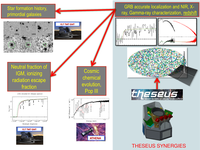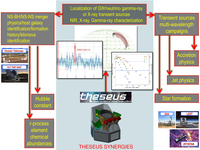THESEUS: a new window on the early Universe and the multi-messenger transient sky
On May 7th 2018, the European Space Agency (ESA) announced the three space missions selected, out of 25 proposed, for ESA’s fifth medium class mission in its Cosmic Vision science programme, with a planned launch date in 2032.
One of these three missions is THESEUS (Transient High-Energy Sky and Early Universe Surveyor), a project developed in the last years by a large European consortium, with interest in prospective participation by research groups in USA and other non-European countries, in which the Italian National Institute for Astrophysics (INAF) plays a major role. THESEUS aims to explore the early (first billion years) Universe through high-redshift Gamma-Ray Bursts (GRBs), the most extreme explosions in the cosmos, and to provide detection, accurate location and redshift of the electro-magnetic counterparts of gravitational-waves and neutrino sources, as well as of many other transient celestial sources.
“THESEUS will eventually allow us to fully exploit the great potential of the GRBs for cosmology purposes, especially in the study of the primordial universe, and it will provide a fundamental contribution to the time-domain and multi-messenger astrophysics” says Lorenzo Amati from INAF in Bologna, Lead Proposer of the mission. “THESEUS will thus provide a unique and fundamental contribution to several fields of astrophysics, cosmology and fundamental physics and will operate in beautiful synergy with the large worldwide facilities planned for the next decade devoted to the study of our Comsos, such as Lsst, Elt, Ska, Cta, Athena, aLigo, aVirgo, Kagra, Et and Km3NeT, thus enhancing importantly their scientific return”.
THESEUS will also operate as a more general multi-purpose and flexible IR and X-ray observatory, thus granting, in a way similar to the NASA Swift mission, an even larger involvement of the astrophysical community.
The selection of THESEUS by ESA further demonstrates the unique expertise and leadership of Europe, and Italy in particular (e.g., scientific and technological heritage from the Italian space missions BeppoSAX, Agile and INTEGRAL R&D on enabling technologies funded by INFN, ASI, INAF), in the above frontier fields of modern astrophysics and cosmology, as well as in the key-enabling technologies.
Through a national consortium supported by the Italian Space Agency (ASI), led by INAF and with the participation of the Italian National Institute for Nuclear Physics (INFN), Politecnico di Milano and several Universities, Italy will provide the X-Gamma-Ray Imaging Spectrometer (XGIS), one of the three instruments of the mission.
 |  |
|---|---|
| THESEUS synergies in the field of the early Universe exploration | THESEUS synergies in the field of the time-domain multi-messenger Astrophysics |
The THESEUS mission was proposed to ESA in 2016 and is under study as the fifth medium-sized mission (M5) in ESA’s ‘Cosmic Vision’ programme. THESEUS was selected along with two other missions for study out of an original 25 proposals. Medium-sized ESA missions have an ESA budget of 550 million euros, together with contributions from ESA member states and other countries. The final decision on which mission to select for launch as M5 will be taken in 2021.




